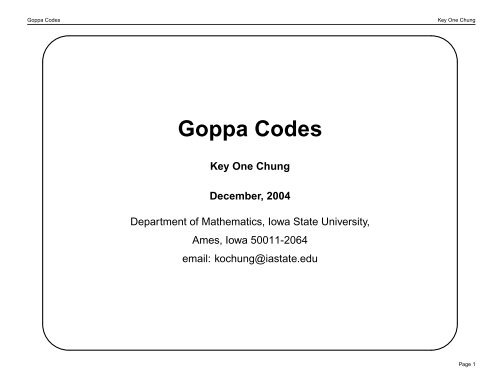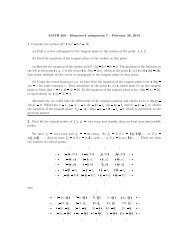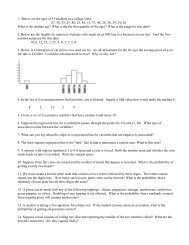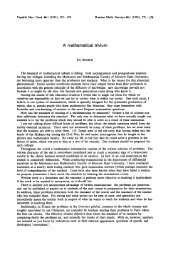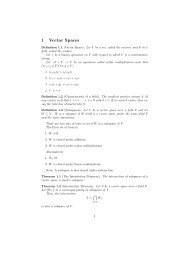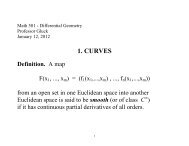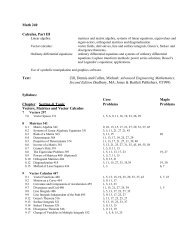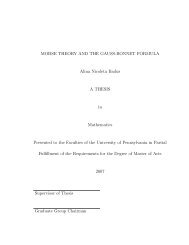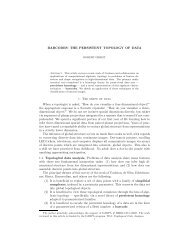Goppa Codes - Department of Mathematics
Goppa Codes - Department of Mathematics
Goppa Codes - Department of Mathematics
You also want an ePaper? Increase the reach of your titles
YUMPU automatically turns print PDFs into web optimized ePapers that Google loves.
<strong>Goppa</strong> <strong>Codes</strong> Key One Chung<br />
✬<br />
✫<br />
<strong>Goppa</strong> <strong>Codes</strong><br />
Key One Chung<br />
December, 2004<br />
<strong>Department</strong> <strong>of</strong> <strong>Mathematics</strong>, Iowa State University,<br />
Ames, Iowa 50011-2064<br />
email: kochung@iastate.edu<br />
✩<br />
✪<br />
Page 1
<strong>Goppa</strong> <strong>Codes</strong> Key One Chung<br />
✬<br />
Contents<br />
1. Introduction<br />
1.1 Linear <strong>Codes</strong><br />
1.2 Bounds on <strong>Codes</strong><br />
1.3 Reed-Solomon <strong>Codes</strong><br />
2. <strong>Goppa</strong> <strong>Codes</strong><br />
2.1 Introduction to <strong>Goppa</strong> <strong>Codes</strong><br />
2.2 Algebraic and Projective Curves<br />
2.3 Nonsingularity and the Genus<br />
2.4 Points, Functions, Divisors on Curves<br />
2.5 Good <strong>Codes</strong> from Algebraic geometry<br />
3. McEliece Cryptosystem<br />
✫<br />
✩<br />
✪<br />
Page 2
<strong>Goppa</strong> <strong>Codes</strong> Key One Chung<br />
✬<br />
1 Introduction<br />
1.1 Linear <strong>Codes</strong><br />
Definition. A linear code C(n, k) over a field F is a vector subspace <strong>of</strong> F n with<br />
dimension k. n is called the length <strong>of</strong> the code C. The minimum distance <strong>of</strong> C is<br />
d := min{d(x, y)|x, y ∈ C, x �= y}, where d(x, y) is the Hamming distance.<br />
(n, k, d) is called the parameter <strong>of</strong> C.<br />
If a basis for C is {r1, . . . , rk}, then<br />
G =<br />
is a generator matrix for C, and C = {uG|u ∈ F<br />
✫<br />
k }.<br />
⎛<br />
⎜<br />
⎝<br />
r1<br />
r2<br />
.<br />
rk<br />
⎞<br />
⎟<br />
⎠<br />
✩<br />
✪<br />
Page 3
<strong>Goppa</strong> <strong>Codes</strong> Key One Chung<br />
✬<br />
What is a good code?<br />
Why are d and k <strong>of</strong> C important?<br />
• dimension k: the larger, the better<br />
✫<br />
We may think <strong>of</strong> each codeword as having k information symbols and n − k<br />
checks. So, large k with respect to n makes an efficient code.<br />
• minimum distance d: the larger, the better<br />
We can correct up to ⌊ d−1<br />
2 ⌋ errors.<br />
How good can a code be?<br />
✩<br />
✪<br />
Page 4
<strong>Goppa</strong> <strong>Codes</strong> Key One Chung<br />
✬<br />
1.2 Bounds on <strong>Codes</strong><br />
Theorem (Singleton Bound). Let C(n, k) be a linear code <strong>of</strong> minimum<br />
distance d over Fq. Then, d ≤ n − k + 1.<br />
Given n, both k and d cannot be large.<br />
Definition. Let q be a prime power and let n, d be positive integers with d ≤ n.<br />
Then the quantity Aq(n, d) is defined as the maximum value <strong>of</strong> M such that<br />
there is a code over Fq <strong>of</strong> length n with M codewords and minimum distance d.<br />
Let Vq(n, r) denote the number <strong>of</strong> elements in the ball <strong>of</strong> radius r centered at x,<br />
for any x ∈ Fn q . Then, Vq(n, r) = �r �<br />
i<br />
i=0 (q − 1) .<br />
Theorem (Gilbert-Varshamov Bound). Aq(n, d) ≥ q n /Vq(n, d − 1).<br />
✫<br />
� n<br />
i<br />
✩<br />
✪<br />
Page 5
<strong>Goppa</strong> <strong>Codes</strong> Key One Chung<br />
✬<br />
Asymptotic Bounds<br />
Definition. Let C be a code over Fq <strong>of</strong> length n with q k codewords and<br />
minimum distance d. The information rate <strong>of</strong> C is R := k/n and the relative<br />
minimum distance <strong>of</strong> C is δ := d/n.<br />
Note that 0 ≤ R, δ ≤ 1, and C is a good code if both R and δ are close to 1.<br />
Definition. Let q be a prime power and δ ∈ R with 0 ≤ δ ≤ 1. Then<br />
✫<br />
αq(δ) := lim sup<br />
n→∞<br />
1<br />
n log q Aq(n, δn).<br />
αq(δ) is the largest R such that there is a sequence <strong>of</strong> codes over Fq with<br />
relative minimum distance converging to δ and information rate converging to R.<br />
✩<br />
✪<br />
Page 6
<strong>Goppa</strong> <strong>Codes</strong> Key One Chung<br />
✬<br />
Set θ = 1 − 1/q.<br />
We define a function Hq(x) on 0 ≤ x ≤ θ by<br />
Hq(x) := 0, if x = 0<br />
✫<br />
x log q(q − 1) − x log q x − (1 − x) log q(1 − x), if 0 < x ≤ θ.<br />
The function Hq is called the Hilbert entropy function.<br />
Theorem (Asymptotic Gilbert-Varshamov Bound). For any δ with 0 ≤ δ ≤ θ,<br />
we have αq(δ) ≥ 1 − Hq(δ).<br />
The Gilbert-Varshamov Bound was the best known lower bound on αq(δ) for a<br />
full 30 years following its original discovery in 1952. In 1982, the existence <strong>of</strong> a<br />
sequence <strong>of</strong> codes having better than The Gilbert-Varshamov Bound was first<br />
proven by Tsfasman, Vladut, and Zink using <strong>Goppa</strong> codes.<br />
✩<br />
✪<br />
Page 7
<strong>Goppa</strong> <strong>Codes</strong> Key One Chung<br />
✬<br />
1.3 Reed-Solomon <strong>Codes</strong><br />
Definition. Lr := {f ∈ Fq[x]|deg(f) ≤ r} � {0}<br />
Note that Lr is a vector subspace over Fq.<br />
Definition. F ∗ q = {α1, . . . , αq−1} and 1 ≤ k ≤ q − 1. Then the<br />
Reed-Solomon code RS(k, q) is defined to be<br />
✫<br />
RS(k, q) := {(f(α1), . . . , f(αq−1))|f ∈ Lk−1}.<br />
It is an image <strong>of</strong> a linear transformation ɛ : Lk−1 → F q−1<br />
q<br />
ɛ(f) = (f(α1), . . . , f(αq−1)).<br />
given by<br />
Parameters <strong>of</strong> RS(k, q) are n = q − 1, dim C = k, and d = n − k + 1.<br />
✩<br />
✪<br />
Page 8
<strong>Goppa</strong> <strong>Codes</strong> Key One Chung<br />
✬<br />
• By singleton bound, given n = q − 1 and dimension k, RS(k, q) is the best.<br />
• However, it is a very restrictive class <strong>of</strong> codes because the length is so small<br />
✫<br />
with regard to the alphabet size. (q-1,q)<br />
• In practice, we want to work with codes which are long with respect to the<br />
alphabet size.<br />
✩<br />
✪<br />
Page 9
<strong>Goppa</strong> <strong>Codes</strong> Key One Chung<br />
✬<br />
2 <strong>Goppa</strong> <strong>Codes</strong><br />
2.1 Introduction to <strong>Goppa</strong> <strong>Codes</strong> (1981)<br />
1. Choose a finite field Fq.<br />
2. Choose a projective nonsingular plane curve X over Fq.<br />
3. Pick n distinct Fq-rational points<br />
✫<br />
P = {P1 . . . , Pn} ⊂ X(Fq) on X.<br />
4. Choose a divisor D on X such that P � supp(D) = ∅.<br />
5. <strong>Goppa</strong> code<br />
C(X, P, D) := {(f(P1, . . . , f(Pn)))|f ∈ L(D)} ⊂ F n q .<br />
✩<br />
✪<br />
Page 10
<strong>Goppa</strong> <strong>Codes</strong> Key One Chung<br />
✬<br />
Note<br />
1. dim C = dim L(D)<br />
2. If {f1, . . . , fk} is a basis for L(D) over Fq, then<br />
⎛<br />
⎜<br />
⎝<br />
✫<br />
f1(P1) · · · f1(Pn)<br />
.<br />
. . .<br />
fk(P1) · · · fk(Pn)<br />
.<br />
⎞<br />
⎟<br />
⎠<br />
is a generator matrix for C.<br />
3. It is the first infinite family <strong>of</strong> codes whose parameters beats the<br />
Gilbert-Varshamov bound.<br />
✩<br />
✪<br />
Page 11
<strong>Goppa</strong> <strong>Codes</strong> Key One Chung<br />
✬<br />
2.2 Algebraic and Projective Curves<br />
k denotes the algebraic closure <strong>of</strong> the field k.<br />
Definition. We define the affine place A 2 (k) to be the set k 2 .<br />
Definition. If f ∈ k[x, y], then the affine(algebraic) curve is defined to be<br />
✫<br />
Cf := {P ∈ A 2 |f(P ) = 0}.<br />
Let X be an algebraic curve over k. Then,<br />
I(X) = {f ∈ k[x, y]|f(P ) = 0 for all P ∈ X}<br />
is an ideal <strong>of</strong> k[x, y]. The quotient ring Γ(X) = k[x, y]/I(X) is called the<br />
coordinate ring <strong>of</strong> X.<br />
✩<br />
✪<br />
Page 12
<strong>Goppa</strong> <strong>Codes</strong> Key One Chung<br />
✬<br />
Example. f(x, y) = y − x 2 and g(x, y) = y − c ∈ R[x, y].<br />
In R, if c > 0, then we have two intersections.<br />
If c = 0, then we have a single intersection <strong>of</strong> multiplicity 2.<br />
In C = R, |Cf<br />
✫<br />
� Cg| = 2.<br />
If g(x, y) = x − c, then we have one intersection. However, if we regard Cf<br />
�<br />
Cg| = 2.<br />
and Cg intersect once at “infinity” as well, then |Cf<br />
✩<br />
✪<br />
Page 13
<strong>Goppa</strong> <strong>Codes</strong> Key One Chung<br />
✬<br />
For given f(x, y) ∈ k[x, y], we construct the polynomial<br />
✫<br />
F (X, Y, Z) = Z d f(X/Z, Y/Z) ∈ k[X, Y, Z]<br />
where d = deg(f). The polynomial F is called the homogenization <strong>of</strong> f .<br />
Observation<br />
• f(x0, y0) = 0 ⇔ F (x0, y0, 1) = 0<br />
• For any α ∈ k ∗ , we have F (αX, αY, αZ) = α d F (X, Y, Z).<br />
So, F (X0, Y0, Z0) = 0 ⇔ F (αX0, αY0, αZ0) = 0 for all α ∈ k ∗ .<br />
⇒ We identify the solutions (X0, Y0, Z0) and (αX0, αY0, αZ0).<br />
• Since F is homogeneous, F (0, 0, 0) = 0.<br />
⇒ We ignore the solution (0, 0, 0) <strong>of</strong> F = 0.<br />
✩<br />
✪<br />
Page 14
<strong>Goppa</strong> <strong>Codes</strong> Key One Chung<br />
✬<br />
Definition. The projective plane is<br />
✫<br />
P 2 (k) := (k 3 \{(0, 0, 0)})/ ∼<br />
where (X0, Y0, Z0) ∼ (X1, Y1, Z1) if and only if there is some α ∈ k ∗ with<br />
X1 = αX0, Y1 = αY0, and Z1 = αZ0. We write (X0 : Y0 : Z0) for the<br />
equivalence class <strong>of</strong> (X0, Y0, Z0) in P 2 .<br />
By multiplying through by a unit, we have<br />
P 2 (k) = {(X0 : Y0 : 1)|X0, Y0 ∈ k} � {(X0 : 1 : 0)|X0 ∈ k}<br />
� {(1 : 0 : 0)}.<br />
Any point <strong>of</strong> the form (X : Y : 0) is called a point at infinity.<br />
✩<br />
✪<br />
Page 15
<strong>Goppa</strong> <strong>Codes</strong> Key One Chung<br />
✬<br />
Definition. Let F be the homogenization <strong>of</strong> f . Then the projective curve <strong>of</strong> F is<br />
✫<br />
�Cf := {(X0 : Y0 : Z0) ∈ P 2 (k)|F (X0, Y0, Z0) = 0}.<br />
Example. f(x, y) = y − x 2 , g(x, y) = x − c. What is � Cf<br />
F (X, Y, Z) = Z 2 (Y/Z − (x/Z) 2 ) = Y Z − X 2<br />
G(X, Y, Z) = X − cZ<br />
When Z = 1, Y = X 2 and X = c. So, we have (c : c 2 : 1).<br />
When z = 0, X = 0 = X 2 . So, we have (0 : 1 : 0).<br />
Therefore, | � Cf<br />
� �Cg| = 2.<br />
� �Cg?<br />
Theorem (Bezout’s Theorem). If f, g ∈ k[x, y] are polynomials <strong>of</strong> degree d<br />
and e respectively, then Cf and Cg intersect in at most de points. Further, � Cf<br />
and � Cg intersect in exactly de points <strong>of</strong> P 2 (k), when points are counted with<br />
multiplicity.<br />
✩<br />
✪<br />
Page 16
<strong>Goppa</strong> <strong>Codes</strong> Key One Chung<br />
✬<br />
2.3 Nonsingularity and the Genus<br />
For coding theory, we only want to work with “nice” curves. Since we have already<br />
decided to restrict ourselves to plane curves, the only other restriction we will<br />
need is that our curve will be nonsingular.<br />
Definition. Let f(x, y) ∈ k[x, y]. A singular point <strong>of</strong> Cf is a point p ∈ k × k<br />
such that f(p) = fx(p) = fy(p) = 0. The curve Cf is nonsingular if it has no<br />
singular points. If F is the homogenization <strong>of</strong> f , then P ∈ P 2 (k) is a singular<br />
point <strong>of</strong> � Cf if f(P ) = FX(P ) = FY (P ) = FZ(P ) = 0. The curve � Cf is<br />
nonsingular if it has no singular points.<br />
Note. Intuitively, a singular point is a point where the curve does not have a<br />
well-defined tangent line, or where it intersects itself.<br />
Definition (Plücker Formula). Let f(x, y) ∈ k[x, y] be a polynomial <strong>of</strong> degree<br />
d such that � Cf is nonsingular. Then the genus <strong>of</strong> Cf (or <strong>of</strong> � Cf ) is defined to be<br />
✫<br />
g :=<br />
(d − 1)(d − 2)<br />
.<br />
2<br />
✩<br />
✪<br />
Page 17
<strong>Goppa</strong> <strong>Codes</strong> Key One Chung<br />
✬<br />
2.4 Points, Functions, Divisors on Curves<br />
Definition. Let C be the projective plane curve defined by F = 0, where<br />
F ∈ k[X, Y, Z] is a homogeneous polynomial. Let K be an extension field <strong>of</strong> k.<br />
We define a K-rational point on C to be a point (X0, Y0, Z0) ∈ P 2 (K) such<br />
that F (X0, Y0, Z0) = 0. C(K) denotes the set <strong>of</strong> all K-rational points on C.<br />
Definition. Let C be a nonsingular projective plane curve. A point <strong>of</strong> degree n<br />
on C over Fq is a set P = {P0, . . . , Pn−1} <strong>of</strong> n distinct points in C(Fq n)<br />
such that Pi = σ i q,n(P0) for i = 1, . . . , n − 1, where σ i q,n : Fq n → Fq n is<br />
the Frobenius automorphism with σq,n(α) = α q .<br />
Note. Elements <strong>of</strong> C(k) are called points <strong>of</strong> degree one or simply rational points.<br />
✫<br />
✩<br />
✪<br />
Page 18
<strong>Goppa</strong> <strong>Codes</strong> Key One Chung<br />
✬<br />
Example. Let C0 be the projective plane curve over F3 corresponding to<br />
✫<br />
f(x, y) = y 2 − x 3 − 2x − 2 ∈ F3[x, y].<br />
Homogenization; F (X, Y, Z) = Y 2 Z − X 3 − 2XZ 2 − 2Z 3 = 0<br />
FX = − 4Z = 2Z = 0<br />
FY = 2Y Z = 0<br />
FZ = Y 2 − 4XZ = Y 2 + 2XZ = 0<br />
⇒ Z = Y = X = 0. So, C0 is nonsingular.<br />
Also, genus g = 2·1<br />
2<br />
= 1.<br />
✩<br />
✪<br />
Page 19
<strong>Goppa</strong> <strong>Codes</strong> Key One Chung<br />
✬<br />
Now, let’s find points <strong>of</strong> degree 1(rational points) C0(F3).<br />
✫<br />
y 2 − x 3 − 2x − 2 = 0<br />
If x = 0, then y 2 = 2. No such elements in F3.<br />
If x = 1, then y 2 = 2. No such elements in F3.<br />
If x = 2, then y 2 = 2. No such elements in F3.<br />
So, no rational points <strong>of</strong> the type (X : Y : 1).<br />
When Z = 0, −X 3 = 0. So, X = 0.<br />
So, C0(F3) = {P∞ := (0 : 1 : 0)}.<br />
✩<br />
✪<br />
Page 20
<strong>Goppa</strong> <strong>Codes</strong> Key One Chung<br />
✬<br />
To find the points <strong>of</strong> degree 2, let’s compute C0(F 3 2) first.<br />
Note that t 2 + 1 is irreducible over F3. Then F9 = F3[t]/(t 2 + 1).<br />
Let α ∈ F9 corresponding t. Then, F9 = {a + bα|a, b ∈ F3}, where<br />
α 2 = −1 = 2. When Z = 1, Y 2 − X 3 − 2X − 2 = 0.<br />
If X = 0, Y 2 = 2 ⇒ Y = α or −α = 2α.<br />
So, (0 : α : 1), (0 : 2α : 1) ∈ C0(F9).<br />
By doing similar computation,<br />
✫<br />
C0(F9) = {(0 : α : 1), (0 : 2α : 1), (1 : α : 1), (1 : 2α : 1),<br />
(2 : α : 1), (2 : 2α : 1), P∞}.<br />
Frobenius map σ3,2 : F9 → F9; α ↦→ α 3 = 2α<br />
Then, σ3,2(0 : α : 1) = (0 : 2α : 1).<br />
So, we have one point Q1 = {(0 : α : 1), (0 : 2α : 1)} <strong>of</strong> degree 2.<br />
Similarly, Q2 = {(1 : α : 1), (1 : 2α : 1)}, Q3 = {(2 : α : 1), (2 : 2α : 1)}.<br />
So, we have three points <strong>of</strong> degree two on C0.<br />
✩<br />
✪<br />
Page 21
<strong>Goppa</strong> <strong>Codes</strong> Key One Chung<br />
✬<br />
Similarly, F 3 3 = F3[t]/(t 3 + 2t + 2) and let w ∈ F27 corresponding to t.<br />
Then, we have<br />
✫<br />
C0(F27) = {(w : 0 : 1), (1 + w : 0 : 1), . . . ,<br />
with 28 F27-rational points.<br />
Also, we see that<br />
(1 + 2w + 2w 2 : 1 + 2w + 2w 2 : 1), P∞}.<br />
C0(F27) = R1<br />
� · · · � R9<br />
� {P∞}<br />
where R1, . . . , R9 are the nine points <strong>of</strong> degree three on C0.<br />
For example, R1 = {(w : 0 : 1), (1 + w : 0 : 1), (2 + w : 0 : 1)}.<br />
✩<br />
✪<br />
Page 22
<strong>Goppa</strong> <strong>Codes</strong> Key One Chung<br />
✬<br />
Let C and C ′ be two projective plane curves over Fq defined by polynomials <strong>of</strong><br />
degree d and e respectively. Then, the set <strong>of</strong> points over Fq where they intersect<br />
will cluster into points P1, . . . , Pl <strong>of</strong> varying degrees over Fq, where a point is<br />
listed more than once if the intersection <strong>of</strong> the two curves is with multiplicity<br />
greater than one.<br />
Let ri denote the degree <strong>of</strong> the point Pi over Fq. Then, we have<br />
de = r1 + r2 + · · · + rl. In this case, we write<br />
✫<br />
C � C ′ = P1 + · · · + Pl<br />
and call C � C ′ the intersection divisor <strong>of</strong> C and C ′ .<br />
✩<br />
✪<br />
Page 23
<strong>Goppa</strong> <strong>Codes</strong> Key One Chung<br />
✬<br />
Definition. • Let C be a curve defined by over Fq. A divisor D on C over Fq<br />
✫<br />
is an element <strong>of</strong> the free abelian group on the set <strong>of</strong> points(<strong>of</strong> arbitrary<br />
degree) on C over Fq.<br />
Thus every divisor is <strong>of</strong> the form D = � nQQ, where the nQ are integers<br />
and each Q is a point (<strong>of</strong> arbitrary degree) on C.<br />
• If nQ ≥ 0 for all Q, we call D effective and write D ≥ 0.<br />
• We define the degree <strong>of</strong> the divisor D = � nQQ to be<br />
deg D = � nQdeg Q.<br />
• the support <strong>of</strong> the divisor D = � nQQ is supp D = {Q|nQ �= 0}.<br />
Note C � C ′ is an effective divisor <strong>of</strong> degree de.<br />
✩<br />
✪<br />
Page 24
<strong>Goppa</strong> <strong>Codes</strong> Key One Chung<br />
✬<br />
Definition. Let F (X, Y, Z) be the polynomial which defines the nonsingular<br />
projective plane curve C over the field Fq. The field <strong>of</strong> rational functions on C is<br />
Fq(C) :=<br />
✫<br />
��<br />
g(X, Y, Z)<br />
h(X, Y, Z) |g, h ∈ Fq[X,<br />
�<br />
�{0}<br />
�<br />
Y, Z] hom. same deg<br />
where g/h ∼ g ′ /h ′ if and only if gh ′ − g ′ h ∈ 〈F 〉 ⊂ Fq[X, Y, Z].<br />
Example F (X, Y, Z) = Y 2 Z − X 3 − 2XZ 2 − 2Z 3 ∈ F3[X, Y, Z].<br />
Then X 2 /Z 2 = (Y 2 + XZ + Z 2 )/XZ in F3(C0)<br />
since<br />
X 2 (XZ) − Z 2 (Y 2 + XZ + Z 2 ) = Z(X 3 − ZY 2 − XZ 2 − Z 3 ) ∈ 〈F 〉.<br />
/ ∼<br />
✩<br />
✪<br />
Page 25
<strong>Goppa</strong> <strong>Codes</strong> Key One Chung<br />
✬<br />
Definition. Let C be a curve defined over Fq and let f := g/h ∈ Fq(C). The<br />
divisor <strong>of</strong> f is defined to be div(f) := � P − � Q, where � P is the<br />
intersection divisor C � Cg and � Q the intersection divisor C � Ch.<br />
Note that since deg(C � Cg) = deg(C � Ch), we have deg div(f) = 0.<br />
Definition. Let D be a divisor on the nonsingular projective plane curve C<br />
defined over the field Fq. Then the space <strong>of</strong> rational functions associated to D is<br />
✫<br />
L(D) := {f ∈ Fq(C)|div(f) + D ≥ 0} � {0}.<br />
Note L(D) is a finite dimensional vector space over Fq.<br />
✩<br />
✪<br />
Page 26
<strong>Goppa</strong> <strong>Codes</strong> Key One Chung<br />
✬<br />
Theorem (Riemann-Roch Theorem). Let C be a nonsingular projective plane<br />
curve <strong>of</strong> genus g defined over Fq and let D be a divisor on C. Then<br />
dim L(D) ≥ deg D + 1 − g. Further, if deg D > 2g − 2, then<br />
✫<br />
dim L(D) = deg D + 1 − g.<br />
✩<br />
✪<br />
Page 27
<strong>Goppa</strong> <strong>Codes</strong> Key One Chung<br />
✬<br />
2.5 Good <strong>Codes</strong> from Algebraic geometry<br />
Theorem. Let X be a nonsingular, projective plane curve <strong>of</strong> genus g, defined<br />
over Fq. Let P ⊂ X(Fq) be a set <strong>of</strong> n distinct Fq-rational points on X, and let<br />
D be a divisor on X satisfying 2g − 2 < deg D < n. Then, <strong>Goppa</strong> code<br />
C := C(X, P, D) is linear <strong>of</strong> length n, dimension k := deg D + 1 − g, and<br />
the minimum distance d, where d ≥ n − deg D.<br />
Note The information rate R <strong>of</strong> C is k/n = (deg D + 1 − g)/n and the<br />
relative minimum distance δ <strong>of</strong> C is d/n ≥ (n − deg D)/n.<br />
We want R + δ large. We have<br />
✫<br />
R + δ ≥<br />
deg D + 1 − g<br />
n<br />
+ n − deg D<br />
n<br />
So, for given genus g, it is better to have large n ≤ |X(Fq)|.<br />
= 1 + 1/n − g/n.<br />
✩<br />
✪<br />
Page 28
<strong>Goppa</strong> <strong>Codes</strong> Key One Chung<br />
✬<br />
How many rational points can a curve <strong>of</strong> genus g have?<br />
Theorem (Hasse-Weil). let X be a nonsinguar projective curve <strong>of</strong> genus g over<br />
Fq and set N = |X(Fq)|. Then<br />
✫<br />
|N − (q + 1)| ≤ 2g √ q.<br />
Theorem (Serre). In the situation <strong>of</strong> the above theorem, we have<br />
|N − (q + 1)| ≤ g⌊2 √ q⌋<br />
✩<br />
✪<br />
Page 29
<strong>Goppa</strong> <strong>Codes</strong> Key One Chung<br />
✬<br />
3 McEliece Public Key Cryptosystem<br />
3.1 Idea<br />
Syndrome decoding <strong>of</strong> linear codes (when considered as a decision problem) is<br />
an NP-complete problem if the number <strong>of</strong> errors is not bounded. However, there<br />
are classes <strong>of</strong> linear codes which have very fast decoding algorithms. The basic<br />
idea <strong>of</strong> the McEliece system is to take one <strong>of</strong> these linear codes and disguise it so<br />
that Oscar, when trying to decrypt a message, is forced to use syndrome<br />
decoding, while Bob, who set up the system, can remove the disguise and use<br />
the fast decoding algorithm. McEliece suggested using <strong>Goppa</strong> <strong>Codes</strong>, which are<br />
linear codes with a fast decoding algorithm, in the system, but any linear code<br />
with a good decoding algorithm can be used.<br />
✫<br />
✩<br />
✪<br />
Page 30
<strong>Goppa</strong> <strong>Codes</strong> Key One Chung<br />
✬<br />
3.2 Key Creation<br />
• The private key consists <strong>of</strong> the matrices (S, G, P ), where S is a random,<br />
✫<br />
invertible k × k matrix, P is a random n × n permutation matrix, and G is<br />
the k × n generator matrix <strong>of</strong> a <strong>Goppa</strong> code that corrects up to t errors.<br />
• The public key is the matrix product <strong>of</strong> the three private matrices, so it is a<br />
k × n matrix � G = SGP . Additionally, a number t ′ ≤ t has to be advertised<br />
which stands for the number <strong>of</strong> errors that a sender <strong>of</strong> a message is allowed<br />
to add to his message. So the public key is ( � G, t ′ ).<br />
✩<br />
✪<br />
Page 31
<strong>Goppa</strong> <strong>Codes</strong> Key One Chung<br />
✬<br />
3.3 Encryption<br />
The plain text is dissected into blocks <strong>of</strong> size k bits. For every block a random<br />
error vector <strong>of</strong> size n that has at most t ′ entries is chosen and is added to the<br />
encoding � G:<br />
3.4 Decryption<br />
✫<br />
c = m � G + e<br />
The receiver multiplies the cipher text with the inverse <strong>of</strong> the permutation matrix:<br />
c ′ = cP −1 = m � GP −1 + eP −1 = mSG + eP −1<br />
Since G is a t error correcting code and eP −1 will contain at most the t ′ ≤ t<br />
intentional errors, he can quickly <strong>Goppa</strong> decode into c ′ and already has the result<br />
mS. To get the plain text messages he will then multiply with the inverse <strong>of</strong> S.<br />
m = mSS −1<br />
✩<br />
✪<br />
Page 32
<strong>Goppa</strong> <strong>Codes</strong> Key One Chung<br />
✬<br />
3.5 Security<br />
To be able to use a trap door <strong>Goppa</strong> code to decipher a message, the inverse<br />
matrices <strong>of</strong> P and S have to be known. If some unauthorized person does not<br />
have this information, she will face the problem to solve a linear code. With an<br />
average choice <strong>of</strong> t ≥ 50 and n ≥ 2 10 , this is a very difficult problem.<br />
3.6 Drawbacks<br />
• The size <strong>of</strong> the public key � G is quite large. Using the <strong>Goppa</strong> code with<br />
✫<br />
parameters suggested by McEliece, the public key would consist <strong>of</strong> 2 19 bits.<br />
This will certainly cause implementation problems.<br />
• The encrypted message is much longer than the plaintext message. This<br />
increase <strong>of</strong> the bandwidth makes the system more prone to transmission<br />
errors.<br />
✩<br />
✪<br />
Page 33
<strong>Goppa</strong> <strong>Codes</strong> Key One Chung<br />
✬<br />
3.7 Discussion<br />
✫<br />
m −−−→<br />
encrypt c −−−→<br />
encode c ′ −−−−−→<br />
public line c ′ + e −−−→<br />
decode c −−−→<br />
decrypt m<br />
m −−−→<br />
encrypt c = m � G + e −−−−−→<br />
public line c ′ = m � G + e + e ′ −−−→<br />
decrypt m<br />
Assume that we have a <strong>Goppa</strong> code C(n, k) with the minimum distance<br />
d = 2t + 1. As we stated, if t ≥ 50 and n ≥ 2 10 , then McEliece Cryptosystem<br />
is considered to be fairly secure. However, we need a big key size. We know that<br />
cellular phone does not require much security. Therefore, it would be a good<br />
problem to find a proper t, t ′ and n having a little security for cellular phone and<br />
not so much big key size. In this case, we can correct up to t − t ′ errors.<br />
✩<br />
✪<br />
Page 34
<strong>Goppa</strong> <strong>Codes</strong> Key One Chung<br />
✬<br />
References<br />
[1] J.L. Walker, <strong>Codes</strong> and Curves, American Mathematical Society (2000), 1–44.<br />
[2] J.H. Silverman, The Arithmetic <strong>of</strong> Elliptic Curves, Springer (1986), 1–44.<br />
[3] P.J. Morandi, Error Correcting <strong>Codes</strong> and Algebraic Curves, Lecture Notes<br />
✫<br />
(2001), 3–63, http://emmy.nmsu.edu/ pmorandi/math601f01/LectureNotes.pdf.<br />
[4] B. Cherowitzo ,<br />
http://www-math.cudenver.edu/ wcherowi/courses/m5410/ctcmcel.html.<br />
[5] http://entropy.stop1984.com/en/mceliece.html.<br />
✩<br />
✪<br />
Page 35


